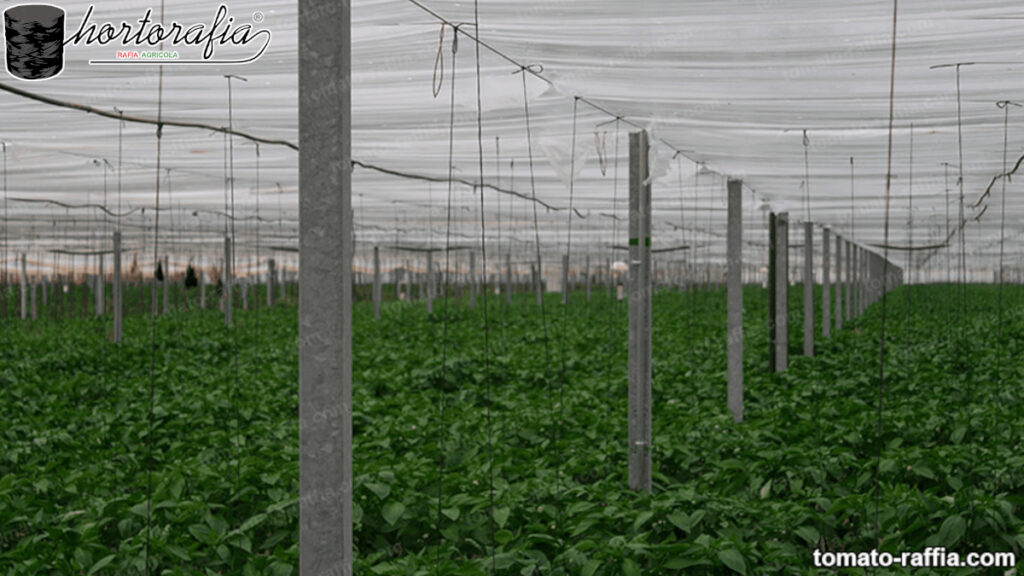Tomato raffia is a flexible, soft and very resistant strip of plastic. It is made primarily of homopolymer, a material specifically designed for use in agricultural plants. Due to its versatility and the fact that it is not easily cut, it can be used for a long time as a climbing support for tomatoes, that is, allowing the plants to grow. This raffia is also used to ring the stems of tomatoes, which improves their support and helps keep them healthy. Some of the main advantages of tomato raffia are its durability and versatility. The material is completely weather resistant so it won’t break easily. In addition, it can be used for many different purposes, such as tomato support, wrapping, as well as being anti-slip and a particle stabilizer. If used correctly, it can not only increase tomato production, but also reduce production costs.
An additional notable fact about using raffia for tomatoes is its stability. Plastic materials are generally stronger than other materials, which means they can better withstand high winds. This means that tomatoes grown with it will have longer lasting fertility. Because of this feature, tomato growers can grow their own tomato varieties without risking damage to their crops. In addition, it can be used in conjunction with other materials to increase productivity. For example, it can be used to cover the soil in tomato fields to prevent sunlight from damaging the soil. In this way, tomatoes receive better sunlight, which improves their flavor and health. They can also be used to improve the resistance of tomatoes to UV rays. This prevents tomatoes from breaking due to solar radiation. Tomato raffia is an essential material for many modern growers.
Advantages offered by tomato raffia
It offers many different advantages, such as increased stability for tomato crops, improves tomato fertility and can also be used to improve the UV resistance of tomatoes. It is a flexible and resistant material, which can be useful for covering tomato fields to improve tomato quality. Tomato raffia is an essential component for the grower to obtain the maximum yield of tomatoes in the fields. There are several types of tomato raffia, and each has its own advantages and characteristics. Using the right raffia for a given crop can help with better heat retention, better ventilation, better yields, and ultimately higher production and improved quality and health. One of the main types of raffia for tomatoes is braided raffia.
This raffia is composed of three layers: a UV-resistant outer layer to protect the fruit from any extreme environmental conditions, an aluminum middle layer for better diffusion of natural heat and an elastomer inner layer for optimum elastic resistance. The raffia is easy to install, each thread wraps around the plant to support the fruit without stopping its growth. One more raffia option for tomatoes is ringed raffia. This raffia consists of a strong, flexible fabric that is used to hold tomatoes in the field. This feature prevents tomatoes from falling and injury at harvest time. In addition, raffia with rings adapts to different types of tomato plants in terms of growth, allowing them to grow vertically for better exposure to the equivalent in natural light.
And how can I root tomatoes in the greenhouse with raffia?
Staking is one of the tools used to increase tomato production in a greenhouse. It can be done using various techniques, such as supports and climbers, but the raffia staking method is one of the most popular options. This is because raffia can be purchased inexpensively, is lightweight, durable, and easy to work with. If you want to use the raffia staking technique to improve the yields of your tomatoes in the greenhouse, follow these simple tips. Before you start staking tomato plants, it is important to prepare the area. If the greenhouse has a frame structure, it should be well signed and centered, and the appropriate supports will need to be anchored. This will serve as an anchor point for the raffia. If the frame is too flimsy, it is recommended that an added structure be built to secure the anchor points.
Use of raffia
Once the frame is ready, it is time to anchor the raffia. The raffia should normally be anchored to the top of the trusses. It is recommended to use at least three points per plant to secure the trussing in small greenhouses and up to five points for large greenhouses. This varies depending on the size of the plant. Anchors are made by placing an anchor point at the top of the structure and starting to wind the raffia from that point. After reaching the end of the structure, the ends can be coiled to adjacent anchor points to secure the staking. Once this is done, you can begin to stake the tomato plants in the greenhouse. Staking is recommended for plants when they are young by posing the stems on the raffia to form a loop.
